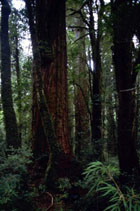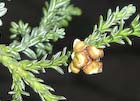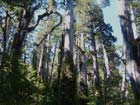Conservation Status

Fitzroya cupressoides
(Molina) I.M.Johnston 1924
Common names
Alerce [Spanish] (Dallimore et al. 1967); in its distribution area, Lahuan is the aboriginal name.
Taxonomic notes
The sole species in Fitzroya Lindl. (1851). Synonyms:
- Libocedrus cupressoides (Molina) Kuntze (1898);
- Abies cupressoides (Molina) Poir. in J.B.A.M.de Lamarck (1804); and
- Pinus cupressoides Molina (1782).
Description
Fitzroya: Evergreen, dioecious tree. Branches not whorled, shoots angular, leaves scale-like, in whorls of 3. Female flowers in cone-like inflorescences, composed of 9 scales in whorls of 3, in 3 alternating whorls; the lowest whorl small and sterile; the middle whorl larger and sterile or with a single 2-winged seed to each scale; the upper whorl fertile, each scale bearing 2-6 two- or three-winged seeds. Cones globose, 6-8 mm across, ripening in the first year; fertile scales with a three-sided mucro at the apex. Seeds 2-6 on each fertile scale, ovate, 2(3)-winged. Cotyledons 2. n =11 (Dallimore et al. 1967, Farjon 1998). Fitzroya is tetraploid, a highly unusual condition in conifers, which are almost all diploid (with the exception of hexaploid Sequoia) (Ahuja 2009).
F. cupressoides: Trees to 45 m tall and 300 cm dbh. Bark reddish, furrowed, peeling off in strips. Branchlets pendulous; leaves in whorls of three, 3.5 mm long, minutely incurved with 2 white bands beneath (Britannica Online, "Alerce", Farjon 1998). "Leaves persisting several years, in alternating whorls of 3, their bases flattened and decurrent, the free part spreading, obovate or oblong lanceolate, about 1/8 in. long with a minute incurved point, upper surface concave with 2 sunken white stomatic bands, lower surface convex with a broad green midrib, on each side of which is a white band of stomata extending from the base to near the apex. Male and female strobili on the same or on different trees, sometimes hermaphrodite. Male strobili solitary in the leaf axils near the points of the shoots, cylindrical with 15-24 stamens in whorls of 3. Female strobili solitary, about 1/4 in. in diameter, on short, stalk-like, leafy shoots. Cones woody, 1/4 - 1/3 in. in diameter, ripening the first year, composed of 9 scales in 3 whorls, the lowest minute and sterile, the middle empty or each bearing a 2-winged seed, the upper scales the largest and bearing 2- or 3-winged seeds, the apex of the cone terminating in gland-like, resin-secreting bodies about 1/8 in. long, which exhale a fragrant odour. Cotyledons 2. Hermaphrodite strobili have a larger number of scales" (Dallimore et al. 1967). See García Esteban et al. (2004) for a detailed characterization of the wood anatomy.
Distribution and Ecology
S Chile & S Argentina "from the coast range south of Valdivia, and on Chiloe Island, to the Andes, between 41°S and 43°S" (Dallimore et al. 1967).
In Argentina, alerce grows on mountain slopes and lake shores, at elevations of 300 to 900 meters. Summer average temperatures are 13-16°C. Winter average temperatures vary from 2-4°C. The area receives 2000-4000 mm. of annual precipitation. In Chile, temperatures can be a bit higher at lower elevations, and rainfall is as high as 6000 mm (Marcelo Fabián Cano, e-mail 2003.12.22). Hardy to Zone 8 (cold hardiness limit between -12.1°C and -6.7°C) (Bannister and Neuner 2001).
Curiously, although the tree grows in virtual rainforest, it is dependent on catastrophic fire in order to regenerate stands; the current widespread decline observed among remnant populations may be due in good measure to fire suppression (Lara et al. 1999).
Remarkable Specimens
The biggest officially recorded specimen in Argentina is 57 meters high, 2.20 meters dbh, and 2600 years old (see pictures at right). It is located near Puerto Sagrario, on the northern branch of Lake Menendez, Los Alerces National Park. This tree is very well known in the area, and there are regular tours to visit the site. Guardaparques (park rangers) state that taller trees (60-70 meters) can be found on the southern branch of Lake Menendez, but that area is restricted to visitors and there aren't trails or roads to get there. Fitzroya may be the tallest gymnosperm in South America, though taller angiosperms have been reported in the Amazonian rainforest.
Darwin saw specimens of up to 130 feet (39.6 m) in girth. A specimen 426 cm dbh is known from the Monumento De Los Alerzales Forest Reserve, Chile (International Dendrology Society Year Book 1991).
The oldest tree is known by a crossdated age of 3622 years for a specimen from Chile collected by Lara and Villalba in 1993 (Lara and Villalba 1993, Brown 1996). This gives it the second-greatest fully verified age recorded for any living tree. In May of 2022, on the basis of a report from Jonathan Barichivich of the Climate and Environmental Sciences Laboratory in Paris, a specimen estimated at 5,484 years with a high likelihood of being more than 5,000 years old was widely reported in the press (e.g., Popkin 2022). The estimate is not incredible, and was in fact developed in cooperation with Antonio Lara, who documented the 1993 age record. However, to date (December 2022), no data have been provided and there has been no independent verification of this age estimate, which is based on extrapolation from a partial tree-ring record. If data are forthcoming, Fitzroya might or might not displace Pinus longaeva as the oldest known non-clonal tree.
Ethnobotany
The reddish brown wood is lightweight, durable, easily worked on account of its straight grain and was formerly much used for shingles, furniture, cooperage, masts, and spars. However, all logging of this extraordinary tree (sometimes called the Sequoia of South America) was officially stopped in 1976 and today relatively few remaining big trees constitute a Chilean national treasure. It is increasingly often used as an ornamental: "It was introduced into cultivation in 1849 by William Lobb and again by Richard Pearce, the Veitchian collector, 10 years later. Although quite hardy in Britain, it is more often seen as a shrub than a tree, but specimens 40 ft. or more high are occasionally met with in the west of England and elsewhere. Probably the tallest is a tree at Killerton, Devon, 53 ft. high, with a girth of 6 ft., in 1964" (Dallimore et al. 1967).
This is an important species in dendrochronology. Early work (Boninsegna and Holmes 1985) established it as the most long-lived species known in South America. Soon after, it was been used to produce a 3622-year reconstruction of mean summer temperatures for southern South America (Lara and Villalba 1993). It has also been used to date glacier fluctuations in Argentina (Villalba et al. 1990). Recent work has continued to push the chronology back using subfossil wood; the Fitzroya chronology currently (Wolodarsky-Franke et al. 2003) stands at 5,666 years, the longest tree-ring record for the southern hemisphere.
Observations
Argentina has preserved outstanding forests of this rare giant in the Parque Nacional Los Alerces. In Chile, old growth stands of Fitzroya can be found in Parque Pumalín, north of Chaitín. Along the trail "El Alerzal" there are dozens of trees 50-70 meters tall and 200-300 cm dbh (Marcelo Fabián Cano, e-mail 22-Dec-2003).
Remarks
The alerce was originally named by Darwin for Captain Fitzroy of H.M.S. Beagle.
The species regenerates both vegetatively and from seed, with vegetative reproduction more common at high altitudes. Seedlings establish preferentially on sunny sites with a decaying wood substrate (Parker and Donoso 1993). This suggests that the species is adapted for gap regeneration following disturbance by storm or wind (rather than fire).
This species is fully protected under Appendix I of CITES (the Convention On International Trade In Endangered Species Of Wild Fauna And Flora (1973, revised 16-Apr-1993)).
A fossil species has been found in Oligocene sediments in Tasmania; thus Fitzroya joins most other Southern Conifer genera in showing Gondwanan affiliations (Hill and Whang 1996).
Citations
Ahuja, M.R. 2009. Genetic constitution and diversity in four narrow endemic redwoods from the family Cupressaceae. Euphytica 165:5-19.
Boninsegna, J.A., Holmes, R.L. 1985. Fitzroya cupressoides yields 1534-year long South American chronology. Tree-Ring Bulletin 45:37-42.
Hill, R.S. and S.S. Whang. 1996. A new species of Fitzroya (Cupressaceae) from Oligocene sediments in north-western Tasmania. Australian Systematic Botany 9(6):867-875.
ABSTRACT: Vegetative twigs from Oligocene sediments in north-western Tasmania are assigned to a new fossil species of Fitzroya, F. tasmanensis. These twigs differ from extant F. cupressoides in leaf shape and stomatal orientation and morphology. This is the first fossil record of Fitzroya from outside the current range of the genus (South America). Previous fossil records of Fitzroya from South America are almost certainly erroneous. These fossils occur in sediments with leaves and cupules of Nothofagus subgenus Nothofagus, which is also restricted to South America today. This suggests that some current plant associations in southern South America provide good analogues for vegetation in Oligocene Tasmania.
Johnston, I. M. 1924. Contr. Gray Herb. 70:91. Available: Biodiversity Heritage Library, accessed 2023.04.10.
Lara, A. and R. Villalba. 1993. A 3620-year temperature record from Fitzroya cupressoides tree rings in southern South America. Science 260: 1104-1106.
Lara, A., S. Fraver, J.C. Aravena, and A. Wolodarsky-Franke. 1999. Fire and the dynamics of Fitzroya cupressoides (alerce) forests of Chile's Cordillera Pelada. Ecoscience 6(1): 100-109.
ABSTRACT: Widespread mortality of Fitzroya cupressoides (alerce) is found throughout the Coastal Range of south-central Chile. The main explanations for tree mortality have been fire and climate change. In order to better understand the dynamics and mortality of Fitzroya in the Cordillera Pelada ('barren range', within the Coastal Range), we established four study plots (with varying degrees of Fitzroya mortality), from which we collected information on tree regeneration, age and size classes of living and dead trees, dates of fire scars from tree stumps, and radial growth rates. The abundance of seedlings and saplings in areas affected by recent, low-intensity fires indicates adequate regeneration of Fitzroya. Age class structures of adult Fitzroya trees from three of the stands show single-cohort populations, suggesting establishment after a stand-devastating disturbance. Fires from two stands were dated to years ranging between 1397 and 1943, indicating that fires have occurred repeatedly over the past 600 years. Tree growth increases immediately after fire. Based on the presence of burned snags, soil charcoal. single-cohort age structures, and numerous dated fire scars, we conclude that repealed fire is the main cause of widespread Fitzroya mortality in the Cordillera Pelada. Since the time of European settlement in southern Chile (ca.1750), fires have mainly been caused by Europeans; however, prior to that time, fires were probably caused by both lightning and native people that inhabited the area.
Lindley. 1851. Notices of certain Ornamental Plants lately introduced into England. Journal of the Horticultural Society of London v. 6, p. 264. Available: Biodiversity Heritage Library, accessed 2023.01.07.
Parker, T. and C. Donoso. 1993. Natural regeneration of Fitzroya cupressoides in Chile and Argentina. Forest Ecology and Management 59(1-2): 63-85.
Popkin, Gabriel. 2022. Is the world’s oldest tree growing in a ravine in Chile? https://www.science.org/content/article/world-s-oldest-tree-growing-ravine-chile, accessed 2022.05.24.
Villalba, R. et al. 1990. Climate, tree-ring, and glacial fluctuations in the Rio Frias Valley, Rio Negro, Argentina. Arctic and Alpine Research 22: 215-232.
Wolodarsky-Franke, Alexia, Antonio Lara and Emilio Cuq. 2003. Development of millennial Fitzroya cupressoides tree-ring chronologies in southern Chile. P. 49 in Programme with Abstracts, Fourth Annual Science Meeting, IAI CRN 03: The Assessment of Past, Present and Future Climate Variability from Treeline Environments. IANIGLA-CRICYT, Mendoza, Argentina, October 10-16, 2003.
See also
Allnutt, T.R.; Newton, A.C.; Lara, A.; Premoli, A.; Armesto, J.J.; Vergara, R.; Gardner, M. 1999. Genetic variation in Fitzroya cupressoides (alerce), a threatened South American conifer. Molecular Ecology 8(6):975-987.
Dimitri, M.; Leonardis, R.; Santos Biloni, J., et al. 1997. El nuevo libro del arbol; tomo I; Editorial El Ateneo; Buenos Aires.
Elwes and Henry 1906-1913 at the Biodiversity Heritage Library (as F. patagonica). This series of volumes, privately printed, provides some of the most engaging descriptions of conifers ever published. Although they only treat species cultivated in the U.K. and Ireland, and the taxonomy is a bit dated, still these accounts are thorough, treating such topics as species description, range, varieties, exceptionally old or tall specimens, remarkable trees, and cultivation. Despite being over a century old, they are generally accurate, and are illustrated with some remarkable photographs and lithographs.
Farjon (2005) provides a detailed account, with illustrations.
Fraver, S., M.E. Gonzalez, F. Silla, A. Lara, and M. Gardner. 1999. Composition and structure of remnant Fitzroya cupressoides forests of southern Chile's Central Depression. Journal of the Torrey Botanical Society 126(1): 49-57.
Haene, E. and Aparicio, G. 2001. 100 Arboles argentinos; Editorial Albatros; Buenos Aires.
Hueck, Kurt. 1978. Los bosques de Sudamérica. Sociedad Alemania de Cooperación Técnica, Ltda. (GTZ).
Premoli, A.C., R. Vergara, C.P. Souto, A. Lara, and A. C. Newton. 2003. Lowland valleys shelter the ancient conifer Fitzroya cupressoides in the Central Depression of southern Chile. Journal of the Royal Society of New Zealand 33(3):623-631.
ABSTRACT: The location of glacial refugia of tree taxa in Patagonia is determined primarily using data from the fossil pollen record. These data suggest that cold-tolerant conifers such as Fitzroya cupressoides probably survived the Last Glacial Maximum in coastal areas of southern Chile, where vegetation types corresponded to those currently found at relatively high altitudes in the Chilean Coastal Range. Much of this region is thought to have been covered by ice. However, the question remains whether F. cupressoides could have persisted locally in ice-free areas within the Central Depression of Chile. In this area, the species has been almost eliminated by human activities that have occurred since the 16th century. Geographic patterns of isozyme variation within 21 populations of F. cupressoides indicated that lowland populations showed high within-population isozyme variation. In addition, lowland populations were clearly differentiated genetically from those on the coast or in the Andes. These results strongly suggest that populations of F. cupressoides persisted in the Central Depression throughout glacial times. This implies that ice caps in the south-western Andes were probably not continuous, but, instead, the existence of ice-free areas in lowland valleys allowed the local survival of cold-temperate woody taxa.
Santos Biloni, J. 1990. Arboles autóctonos argentinos; TEA; Buenos Aires.
Threatened Conifers of the World.
Thanks to Marcelo Fabián Cano, who provided photographs, citations and other information for this page, 2004.01.








